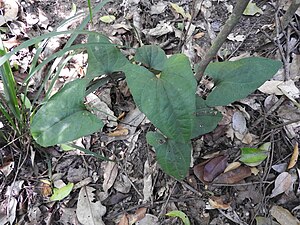Note: This is a project under development. The articles on this wiki are just being initiated and broadly incomplete. You can Help creating new pages.
Trichopus zeylanicus - Jeevani
Trichopus zeylanicus is a small herbaceous plant, which is one of only two species of its genus, Trichopus. Formerly it was placed in its own family, Trichopodaceae, but is now included in the Dioscoreaceae family. The herb grows on sandy soil near rivers and streams in shady places in lowland and intermediate altitude forests. It flowers year long and the fruits are thought to be dispersed by water. The unusual flowers are purplish black.
Uses
Stomach ulcers, Fatigue, Sexual performance problems, Curing liver disorders, Skin eruptions, Heavy fat, Liver problems, Diarrhea, Sore throats
Parts Used
Chemical Composition
Detailed chemical & pharmacological investigations showed that the loaf of the plant contained flavonoid glycosides, glycolipids and some other non – steroidal compounds with profound adaptogenic & immune – enhancing properties.[1]
Common names
| Language | Common name |
|---|---|
| Kannada | |
| Hindi | |
| Malayalam | Arogyapaccka |
| Tamil | Sattithanpatchilai |
| Telugu | |
| Marathi | NA |
| Gujarathi | NA |
| Punjabi | NA |
| Kashmiri | NA |
| Sanskrit | Aarogyapaccha |
| English | Agrimony |
Properties
Reference: Dravya - Substance, Rasa - Taste, Guna - Qualities, Veerya - Potency, Vipaka - Post-digesion effect, Karma - Pharmacological activity, Prabhava - Therepeutics.
Dravya
Rasa
Tikta (Bitter), Kashaya (Astringent)
Guna
Laghu (Light), Ruksha (Dry), Tikshna (Sharp)
Veerya
Ushna (Hot)
Vipaka
Katu (Pungent)
Karma
Kapha, Vata
Prabhava
Habit
Identification
Leaf
| Kind | Shape | Feature |
|---|---|---|
| Simple | Leaves ovate-lanceolate, acute or obtuse, apiculate, base deeply cordate, to 12 x 7 cm; 5-7 ribbed, petiole to 5 cm. |
Flower
| Type | Size | Color and composition | Stamen | More information |
|---|---|---|---|---|
| Bisexual | Maroon | 6 | Flowers fascicled at the base of the petiole. Perianth dark brown, campanulate, lobes lanceolate. Stamens 6, anthers apiculate. |
Fruit
| Type | Size | Mass | Appearance | Seeds | More information |
|---|---|---|---|---|---|
| Fruit triquetrous, purple-brown; seeds dorsally grooved. | {{{6}}} |
Other features
List of Ayurvedic medicine in which the herb is used
- Vishatinduka Taila as root juice extract
Where to get the saplings
Mode of Propagation
How to plant/cultivate
The licence to provide jeevani was granted to Arya Vaidya Pharmacy. A regular supply of the leaves of the plant was required. Scientifiec studies revealed that the medicinal properties of the plant are best manifested in plants growing in natural habitat.[3]
Commonly seen growing in areas
Photo Gallery
References
External Links
- Ayurvedic Herbs known to be helpful to treat Stomach ulcers
- Ayurvedic Herbs known to be helpful to treat Fatigue
- Ayurvedic Herbs known to be helpful to treat Sexual performance problems
- Ayurvedic Herbs known to be helpful to treat Curing liver disorders
- Ayurvedic Herbs known to be helpful to treat Skin eruptions
- Ayurvedic Herbs known to be helpful to treat Heavy fat
- Ayurvedic Herbs known to be helpful to treat Liver problems
- Ayurvedic Herbs known to be helpful to treat Diarrhea
- Ayurvedic Herbs known to be helpful to treat Sore throats
- Herbs with Leaves used in medicine
- Herbs with Rhizome used in medicine
- Herbs with Fruits used in medicine
- Herbs with common name in Malayalam
- Herbs with common name in Tamil
- Herbs with common name in Sanskrit
- Herbs with common name in English
- Habit - Small herbaceous plant
- Index of Plants which can be propagated by Seeds
- Herbs that are commonly seen in the region of Peninsular Malaysia
- Herbs that are commonly seen in the region of Southern Peninsular Thailand
- Herbs that are commonly seen in the region of Southern India
- Herbs
- Ayurvedic herbs that don't have seed photos
- Dioscoreaceae






